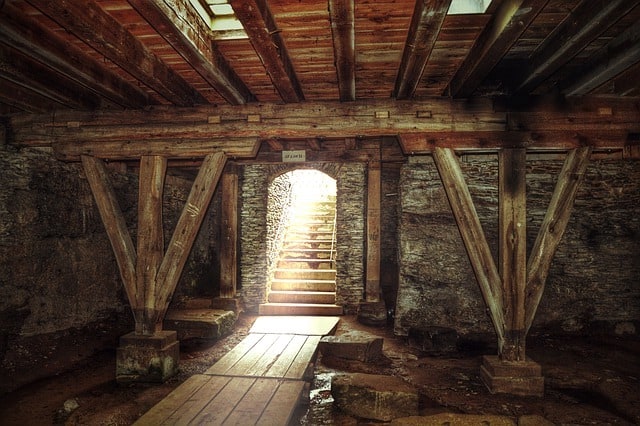
Damp Proofing Coal Vaults in London
A Guide to Converting a Cellar
With property prices higher than ever and many people struggling to get onto the property ladder, home extensions are becoming a worthwhile option for people who need more space at home but would struggle to buy a bigger house. Rear extensions are a popular option, but if you don’t have much outside space or garden to build into, you might be put off the idea of doing this due to losing out on garden space. Building upwards with a loft conversion or attic conversion is another option to consider, but this can also be difficult to navigate with planning permission and other factors. Because of this, we’re seeing an increase in the number of homeowners deciding to go with a cellar or basement conversion in their homes.
Types of Cellar Conversion
There are several different types of cellar conversion to consider for your home. These include:
- Cellar refurbishment: This refers to an existing cellar being refurbished to create a new, fresh, and welcoming space. If you already have a cellar at your home, it is the easiest and most affordable option to consider.
- Retrofit basement: With this option, a basement or cellar is built onto an existing home. It will require excavation and underpinning to the party walls before the cellar can be built. The structure can either fit into the property’s established boundaries or extend further outwards.
- Newbuild Basement: This involves constructing a basement at the same time as a new home. Since the property is not inhabited at the time, this can be beneficial due to the limited disruption.
What are the Benefits of a Cellar Conversion?
Cellars and basements often have a bad reputation, bringing up images of a dingy, dark recess that is only good for storing unwanted items that you haven’t gotten around to throwing away. And while this might have been true a few decades ago, these days, new building technology and innovative architecture mean that dark and damp are no longer impossible to work with. No matter the current state of your cellar, there are many benefits to getting a cellar conversion. One of the biggest advantages is that your cellar can provide an entire new floor in your home that can be used for storage purposes or as a living area.
What Can Cellar Conversions Be Used For?
Many homeowners love their cellar conversions and have many different uses for them. Your cellar conversion can easily become the heart of your home. It can be used as a spacious living room if your property only has a small living space on the ground floor, or you can use it as an additional bedroom and bathroom. Some people like to use their cellar conversion for entertainment purposes with a home cinema and games room, or more recently, with the rise in working from home it could become an ideal home living space. Depending on the size of your cellar, you could even make money from it by turning it into an entire apartment to rent out.
Cellar Conversion Building Regulations
There are several steps that you will need to take in order to successfully convert your cellar. You can do this with the help of several professionals. You will usually need a structural engineer, a plumber, and an electrician to help with your cellar conversion. You may also want to hire a plasterer and a painter and decorator. Depending on what you are going to use your cellar for, you may need to hire other professionals. Before going ahead with the work, check with your local authority to see whether or not you will be required to get planning permission and ensure that your cellar conversion will meet necessary fire safety regulations.
Steps to Convert Your Cellar Into a Room
1 – Hire a Professional
Hiring a professional is one of the first steps that you will need to take on your cellar conversion journey. A professional will be able to help with several steps throughout the process from checking the foundation to planning the final layout of the cellar, the finish, and the décor. A cellar conversion expert is an ideal professional to hire.
2 – Check the Waterproofing and Damp Proofing for Coal Vaults
If you want to convert your cellar or coal vault into a room, then the next step to take is to check the damp proofing and waterproofing. You will need to think about how you are going to waterproof the area. This can impact your home insurance, especially if you live in a flood-risk area.
3 – Plan Levelling of Your Flooring
Flooring is another crucial consideration to make when converting your cellar. This is especially true if you have uneven floors. One of the main ways to do this is by screeding a concrete layer, which will render the floor more even and provide you with a range of flooring options to choose from. Some other options to consider are a floating timber floor. You can also go for underfloor heating if your cellar is particularly cold.
4 – Plan Insulation and Heating
Insulating your cellar will not only make your home more energy-efficient but will also help you create a living space that is cosier and more welcoming. You can choose from loose-fill insulation, blanket insulation, foam boards, and sprayed foam when insulating your cellar. You will also need to plan how you are going to heat your basement. The good news is that there are several options to choose from when it comes to heating including radiators, electric heaters, and underfloor heating.
5 – Plan Lighting
Once you have decided on how you are going to use your cellar and have planned all the important processes mentioned, the main consideration before you start decorating and turning your cellar into a living area is the lighting. While natural light is preferable, not every cellar can have a window installed. In this case, wall lights and spotlights are a good option to light up your basement while still maintaining the height of the ceiling.
6 – Finishing Touches
Once the main things are planned, the final step is to add the finishing touches to the cellar conversion. You can work with an interior decorator to design your new cellar or consider doing it yourself if you have an eye for design and detail. You can use your new cellar in many different ways including as a bedroom, a social living space, storage, home office, or even a wine cellar.
How is Damp Proofing Coal Vaults in London Done?
You can do this in a number of ways including external waterproofing using tanking and the application of fully bonded cement to the walls and floor. Alternatively, you can ensure that water stays out of the cellar or coal vault by using cavity drain membranes.
London Coal Vault Conversion – Damp Proofing
Whether you are considering your cellar to use as a living area or just want to use it for storage, you will need to properly waterproof or tank the area to ensure that your belongings don’t get damp. Waterproofing is also an important step to increase the value of your home as it will make it more appealing to any potential buyers if you want to sell it in the future. When it comes to choosing the type of waterproofing or damp proofing that you need, the type of ground that your home is built on will be the main deciding factor. It’s important to consider what you are going to need for your basement before you get started. If you’re not sure, a cellar conversion professional can help.
Is Converting a Cellar Worth It?
Small or Victorian cellar conversions are sometimes tricker as they were originally designed for storage. In the Victorian age, for example, cellars were used by homeowners to store food, coal, and other items. As a result, if this is the type of basement that you have in your home, it will only usually be worth converting if you want to use them for additional storage space.
What’s Needed to Convert a Cellar?
If you just want to convert your cellar into a single room, then a membrane lining system can be used. This will usually take just a few weeks to install. It will require digging out of the sump and fitting the pumping system. Alternatively, if you’re planning to turn the cellar into multiple rooms and create a new living space, you will need to underpin, waterproof, and insulate the existing structure, which can take several months.
Is Planning Permission Needed?
You will need to get building regulations approval if you are converting your cellar into a liveable space. However, you will not need to check building regulations if your cellar has already been renovated and you simply want to make repairs or redecorate. Planning permission will not usually be required unless the renovation is going to alter the house’s external façade.
A cellar conversion can be an ideal way to get more room in your property without the need to extend outwards. However, a lot of planning is required to turn a cellar into a liveable area in your property.

